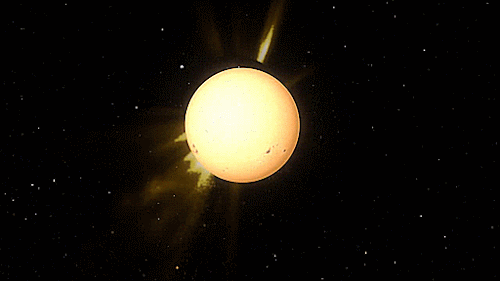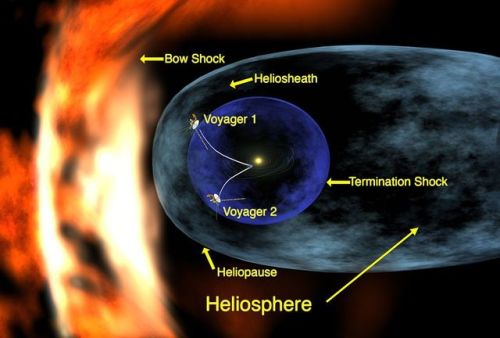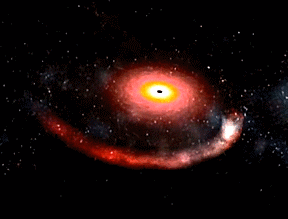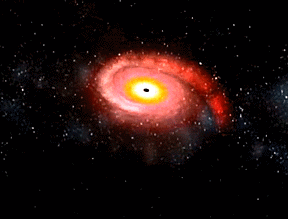Image Credit:NASA/JPL-Caltech


Image Credit:NASA/JPL-Caltech
In this large celestial mosaic, our Spitzer Space Telescope captured a stellar family portrait! You can find infants, parents and grandparents of star-forming regions all in this generational photo. There’s a lot to see in this image, including multiple clusters of stars born from the same dense clumps of gas and dust – some older and more evolved than others. Dive deeper into its intricacies by visiting https://go.nasa.gov/2XpiWLf
Make sure to follow us on Tumblr for your regular dose of space: http://nasa.tumblr.com.
More Posts from Ocrim1967 and Others




The heliosphere is the bubble-like region of space dominated by the Sun, which extends far beyond the orbit of Pluto. Plasma “blown” out from the Sun, known as the solar wind, creates and maintains this bubble against the outside pressure of the interstellar medium, the hydrogen and helium gas that permeates the Milky Way Galaxy. The solar wind flows outward from the Sun until encountering the termination shock, where motion slows abruptly. The Voyager spacecraft have explored the outer reaches of the heliosphere, passing through the shock and entering the heliosheath, a transitional region which is in turn bounded by the outermost edge of the heliosphere, called the heliopause. The shape of the heliosphere is controlled by the interstellar medium through which it is traveling, as well as the Sun and is not perfectly spherical. The limited data available and unexplored nature of these structures have resulted in many theories. The word “heliosphere” is said to have been coined by Alexander J. Dessler, who is credited with first use of the word in the scientific literature.
On September 12, 2013, NASA announced that Voyager 1 left the heliopause on August 25, 2012, when it measured a sudden increase in plasma density of about forty times. Because the heliopause marks one boundary between the Sun’s solar wind and the rest of the galaxy, a spacecraft such as Voyager 1 which has departed the heliosphere, can be said to have reached interstellar space. source









(Source)










Happy 230th Birthday, Enceladus, Our Solar System’s Greatest Hope For Life Beyond Earth
“It is still a complete unknown whether Earth is the only world in the Solar System to house any form of life: past or present. Venus and Mars may have been Earth-like for a billion years or more, and life could have arisen there early on. Frozen worlds with subsurface oceans, like Enceladus, Europa, Triton or Pluto, are completely different from Earth’s present environment, but have the same raw ingredients that could potentially lead to life as well.
Are water, energy, and the right molecules all we need for life to arise? Finding even the most basic organisms (or even the precursor components of organisms) anyplace else in the Universe would lead to a scientific revolution. A single discovered cell in the geysers of Enceladus would be the most momentous discovery of the 21st century. With the recent demise of Cassini, on the 230th anniversary of Enceladus’ discovery, the possibility of finding the incredible compels us to go back. May we be bold enough to make it so.”
On this date in 1789, William Herschel, armed with the most powerful telescope known to humanity at the time (you can get a lot of grant money when you discover the planet Uranus and name it after the King), discovered a relatively small moon of Saturn just 500 kilometers across: Enceladus. For some 200 years, Enceladus was never seen as more than a single pixel across, until the Voyager probes flew by it. What they revealed was a remarkable, unique world in all the Solar System. Now that the Cassini mission is complete, we can look back at all we know about this world, and all the signs point to a remarkable story: there’s a subsurface ocean, possibly suitable as a home for undersea life.
Is Enceladus truly our Solar System’s best hope for life beyond Earth? That’s debatable, but there’s every reason to be hopeful. Come get the story here.
Black holes
A black hole is a region of spacetime exhibiting such strong gravitational effects that nothing—not even particles and electromagnetic radiation such as light—can escape from inside it. The theory of general relativity predicts that a sufficiently compact mass can deform spacetime to form a black hole. The boundary of the region from which no escape is possible is called the event horizon. Although the event horizon has an enormous effect on the fate and circumstances of an object crossing it, no locally detectable features appear to be observed. In many ways a black hole acts like an ideal black body, as it reflects no light.

The idea of a body so massive that even light could not escape was briefly proposed by astronomical pioneer and English clergyman John Michell in a letter published in November 1784. Michell’s simplistic calculations assumed that such a body might have the same density as the Sun, and concluded that such a body would form when a star’s diameter exceeds the Sun’s by a factor of 500, and the surface escape velocity exceeds the usual speed of light.

At the center of a black hole, as described by general relativity, lies a gravitational singularity, a region where the spacetime curvature becomes infinite. For a non-rotating black hole, this region takes the shape of a single point and for a rotating black hole, it is smeared out to form a ring singularity that lies in the plane of rotation. In both cases, the singular region has zero volume. It can also be shown that the singular region contains all the mass of the black hole solution. The singular region can thus be thought of as having infinite density.

How Do Black Holes Form?
Scientists think the smallest black holes formed when the universe began.
Stellar black holes are made when the center of a very big star falls in upon itself, or collapses. When this happens, it causes a supernova. A supernova is an exploding star that blasts part of the star into space.

Scientists think supermassive black holes were made at the same time as the galaxy they are in.
Supermassive black holes, which can have a mass equivalent to billions of suns, likely exist in the centers of most galaxies, including our own galaxy, the Milky Way. We don’t know exactly how supermassive black holes form, but it’s likely that they’re a byproduct of galaxy formation. Because of their location in the centers of galaxies, close to many tightly packed stars and gas clouds, supermassive black holes continue to grow on a steady diet of matter.

If Black Holes Are “Black,” How Do Scientists Know They Are There?
A black hole can not be seen because strong gravity pulls all of the light into the middle of the black hole. But scientists can see how the strong gravity affects the stars and gas around the black hole.
Scientists can study stars to find out if they are flying around, or orbiting, a black hole.

When a black hole and a star are close together, high-energy light is made. This kind of light can not be seen with human eyes. Scientists use satellites and telescopes in space to see the high-energy light.

On 11 February 2016, the LIGO collaboration announced the first observation of gravitational waves; because these waves were generated from a black hole merger it was the first ever direct detection of a binary black hole merger. On 15 June 2016, a second detection of a gravitational wave event from colliding black holes was announced.

Simulation of gravitational lensing by a black hole, which distorts the image of a galaxy in the background
Animated simulation of gravitational lensing caused by a black hole going past a background galaxy. A secondary image of the galaxy can be seen within the black hole Einstein ring on the opposite direction of that of the galaxy. The secondary image grows (remaining within the Einstein ring) as the primary image approaches the black hole. The surface brightness of the two images remains constant, but their angular size varies, hence producing an amplification of the galaxy luminosity as seen from a distant observer. The maximum amplification occurs when the background galaxy (or in the present case a bright part of it) is exactly behind the black hole.
Could a Black Hole Destroy Earth?
Black holes do not go around in space eating stars, moons and planets. Earth will not fall into a black hole because no black hole is close enough to the solar system for Earth to do that.

Even if a black hole the same mass as the sun were to take the place of the sun, Earth still would not fall in. The black hole would have the same gravity as the sun. Earth and the other planets would orbit the black hole as they orbit the sun now.
The sun will never turn into a black hole. The sun is not a big enough star to make a black hole.
More posts about black holes
Source 1, 2 & 3











Unusual Signal Suggests Neutron Star Destroyed by Black Hole
What created this unusual explosion? Three weeks ago, gravitational wave detectors in the USA and Europe – the LIGO and Virgo detectors – detected a burst of gravitational radiation that had the oscillating pattern expected when a black hole destroys a neutron star. One object in event S190814sv was best fit with a mass greater than five times the mass of the Sun – making it a good candidate for a black hole, while the other object appeared to have a mass less than three times the mass of the Sun – making it a good candidate for a neutron star. No similar event had been detected with gravitational waves before. Unfortunately, no light was seen from this explosion, light that might have been triggered by the disrupting neutron star. It is theoretically possible that the lower mass object was also a black hole, even though no clear example of a black hole with such a low mass is known. The featured video was created to illustrate a previously suspected black hole - neutron star collision detected in light in 2005, specifically gamma-rays from the burst GRB 050724. The animated video starts with a foreground neutron star orbiting a black hole surrounded by an accretion disk. The black hole’s gravity then shreds the neutron star, creating a jet as debris falls into the black hole. S190814sv will continue to be researched, with clues about the nature of the objects involved possibly coming from future detections of similar systems. Illustration Video Credit: NASA, Dana Berry (Skyworks Digital)










General Relativity Rules: Einstein Victorious In Unprecedented Gravitational Redshift Test
“The most interesting part of this result is that it clearly demonstrates the purely General Relativistic effect of gravitational redshift. The observations of S0-2 showcase an exact agreement with Einstein’s predictions, within the measurement uncertainties. When Einstein first conceived of General Relativity, he did so conceptually: with the idea that acceleration and gravitation were indistinguishable to an observer.
With the validation of Einstein’s predictions for the orbit of this star around the galactic center’s black hole, scientists have affirmed the equivalence principle, thereby ruling out or constraining alternative theories of gravity that violate this cornerstone of Einsteinian gravity. Gravitational redshifts have never been measured in environments where gravity is this strong, marking another first and another victory for Einstein. Even in the strongest environment ever probed, the predictions of General Relativity have yet to lead us astray.”
If you want to test Einstein’s General Relativity, you’ll want to look for an effect that it predicts that’s unique, and you’ll want to look for it in the strongest-field regime possible. Well, there’s a black hole at the center of our galaxy with 4 million times the mass of the Sun, and there’s a star (S0-2) that passes closer to it, during closest approach, than any other. In May of 2018, it made this closest approach, coming within 18 billion km (about twice the diameter of Neptune’s orbit) of the black hole, and zipping around at 2.7% the speed of light.
Did Einstein’s predictions for gravitational redshift come out right? You bet they did: 5-sigma, baby! Come get the full, amazing story here!










He faced all this for you, for you to be loved, blessed, glorified, exalted, satisfied, accepted, freed and resurrected.


Comet McNaught next to the dome of the NTT on La Silla. The picture was taken in January 2007.
Credit: ESO/H.H.Heyer



Animated Fine Art
Collection by E Lynx of famous artworks that have been animated and rendered in 3D which you can interact with their respective @sketchfab upload:
More Here
-
 thenerdyrehelps liked this · 5 months ago
thenerdyrehelps liked this · 5 months ago -
 nojkno liked this · 1 year ago
nojkno liked this · 1 year ago -
 gypsy-jai liked this · 3 years ago
gypsy-jai liked this · 3 years ago -
 isla-vic liked this · 3 years ago
isla-vic liked this · 3 years ago -
 deepestmongerpaintersludge liked this · 3 years ago
deepestmongerpaintersludge liked this · 3 years ago -
 pinkylover68 liked this · 4 years ago
pinkylover68 liked this · 4 years ago -
 superlucyjin reblogged this · 4 years ago
superlucyjin reblogged this · 4 years ago -
 mypineappleunderthesea liked this · 4 years ago
mypineappleunderthesea liked this · 4 years ago -
 russellfruit liked this · 4 years ago
russellfruit liked this · 4 years ago -
 whenyoufeeljoygiveintoit reblogged this · 4 years ago
whenyoufeeljoygiveintoit reblogged this · 4 years ago -
 ill-take-the-rain reblogged this · 4 years ago
ill-take-the-rain reblogged this · 4 years ago -
 exploring2000 liked this · 4 years ago
exploring2000 liked this · 4 years ago -
 abdelrahman-2020 liked this · 4 years ago
abdelrahman-2020 liked this · 4 years ago -
 improbablyamartian liked this · 4 years ago
improbablyamartian liked this · 4 years ago -
 cleo7 liked this · 4 years ago
cleo7 liked this · 4 years ago -
 shailendra65631 reblogged this · 4 years ago
shailendra65631 reblogged this · 4 years ago -
 shailendra65631 liked this · 4 years ago
shailendra65631 liked this · 4 years ago -
 piqselphoto liked this · 4 years ago
piqselphoto liked this · 4 years ago -
 boaringoldguy liked this · 4 years ago
boaringoldguy liked this · 4 years ago -
 violetsystems reblogged this · 4 years ago
violetsystems reblogged this · 4 years ago -
 ori-the-axolotl liked this · 4 years ago
ori-the-axolotl liked this · 4 years ago -
 dead-in-a-fun-sexy-way liked this · 4 years ago
dead-in-a-fun-sexy-way liked this · 4 years ago -
 sayno58 liked this · 4 years ago
sayno58 liked this · 4 years ago -
 starfaringships reblogged this · 4 years ago
starfaringships reblogged this · 4 years ago -
 planeinsane liked this · 4 years ago
planeinsane liked this · 4 years ago -
 lookingformyperfectsandwich reblogged this · 4 years ago
lookingformyperfectsandwich reblogged this · 4 years ago -
 dirtsa-blog2 liked this · 4 years ago
dirtsa-blog2 liked this · 4 years ago -
 backlovefuck reblogged this · 4 years ago
backlovefuck reblogged this · 4 years ago -
 backlovefuck liked this · 4 years ago
backlovefuck liked this · 4 years ago -
 nightsonmars reblogged this · 4 years ago
nightsonmars reblogged this · 4 years ago -
 pinkiepieaddict reblogged this · 4 years ago
pinkiepieaddict reblogged this · 4 years ago -
 stupidonebada liked this · 4 years ago
stupidonebada liked this · 4 years ago -
 psyykkinen-lintukoto reblogged this · 4 years ago
psyykkinen-lintukoto reblogged this · 4 years ago -
 biromantic-disaster liked this · 4 years ago
biromantic-disaster liked this · 4 years ago -
 nicoleispurple liked this · 4 years ago
nicoleispurple liked this · 4 years ago -
 trans-moth-man liked this · 4 years ago
trans-moth-man liked this · 4 years ago -
 definitelynotstephaniebrown liked this · 4 years ago
definitelynotstephaniebrown liked this · 4 years ago -
 here-comes-the-girl-wonder liked this · 4 years ago
here-comes-the-girl-wonder liked this · 4 years ago